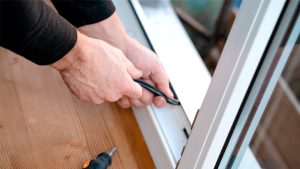Installing windows correctly is as important as choosing the right windows for your home. A proper installation ensures that windows perform their best, keeping water out and helping to maintain the desired indoor climate.
Understanding Window Installation Basics
Before diving into the sealing process, it’s important to understand the basics of window installation:
- Types of Windows: Different windows (like casement, sliding, or double-hung) may require specific installation techniques.
- Installation Environment: The material of the wall (wood, brick, etc.), and whether the window is being installed in a new construction or a replacement scenario, affects the installation process.
Materials Needed for Watertight Sealing
To achieve a watertight seal, you will need the following materials:
- Sealants: Such as silicone or polyurethane.
- Flashing Tape: To direct water away from the window.
- Backer Rods: Foam rods used to fill large gaps before sealing.
Step-by-Step Guide to Watertight Window Installation
Follow these detailed steps to ensure a watertight installation:
- Preparation: Clean and dry all surfaces.
- Apply Flashing Tape: Properly apply flashing tape on the sill and around the window frame.
- Install the Window: Place the window in the opening, ensuring it is level and plumb.
- Sealant Application: Apply sealant around the window frame, both inside and out.
Common Mistakes to Avoid During Installation
Avoid these frequent errors to prevent future water leakage:
- Incorrect Measurements: Always double-check the window and op article ening sizes.
- Inadequate Sealing: Ensure all joints and gaps are fully sealed.
- Poor Flashing Installation: Incorrectly installed flashing can lead to leaks.
Advanced Tips for Enhanced Watertight Sealing
For enhanced protection, consider the following tips:

- Climate Considerations: Use sealants suitable for your local weather conditions.
- Additional Barriers: Use waterproof membranes for extra protection in areas prone to heavy rain.
Maintenance Tips to Sustain Watertight Seals
Regular maintenance is key to long-lasting window seals:
- Inspect Regularly: Check for signs of wear or damage.
- Clean and Repair: Keep the seals clean and repair any damage promptly.
Case Studies and Real-World Examples
Learning from real-world examples can provide valuable insights into effective window sealing techniques.
Conclusion
Properly installed and maintained window seals are crucial for the longevity and efficiency of your windows. By following these guidelines, you can ensure that your windows will remain watertight and functional.

Hello! I’m Tyler Glasheen, your go-to expert at PaneCrafters for all things related to window and door installations. With over 15 years of experience in the industry, I’ve dedicated my career to mastering the art of fitting, upgrading, and maintaining windows and doors for both residential and commercial spaces.




